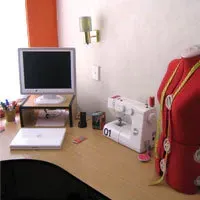The MsBehaviour Files: Design Your Space
Written by

I have just spent a satisfying few weeks, re-designing the Mohawk Media studios. I start every new year throwing out rubbish, filing old paperwork and working out our needs for the year. The process helps clear my head and focus after the holidays. When you design a space whether online or off the first thing to consider is the purpose. What activities do you want to take place in your space, and what outcomes would you like to come from them? I have just spent a satisfying few weeks, re-designing the Mohawk Media studios. I start every new year throwing out rubbish, filing old paperwork and working out our needs for the year. The process helps clear my head and focus after the holidays. When you design a space whether online or off the first thing to consider is the purpose. What activities do you want to take place in your space, and what outcomes would you like to come from them?It's also worth factoring basic psychology into your design, as in my column on Space I covered the importance of ceiling height.
A study by Joan Meyers-Levy found that, 'When participants were aware of the height, high ceilings activated abstract thinking and thoughts of freedom, whereas low ceilings activated concrete thinking and thoughts of confinement.' Bearing this in mind, I now do my 'blue sky thinking' in a room with a high ceiling. I have converted two smaller rooms, one for video & music production, and the other is my writing / podcasting / sewing room (pictured above).
The re-design means that I now have a workshop, where I can happily make lots of mess and not have to clear it up straight away. As I also live in our studios I need to be able to put the office away at the end of the day. Sticking the printer and computers into a cupboard means that it's easy to shut a few doors, forget about work, and move onto play.
If the aim of a creative workspace is to focus attention and stimulate creativity then comfort and control of your environment is a priority. Pixar have taken this to the extreme, and their animators have individuals huts they can decorate in any way they please. Creativity at Work suggests ten tips for a creative space at the office, such as 'Provide a mix of open space for congregating, and closed space for concentration. Creativity is often generated when people interact with one another'. This is why kitchens, sofas and watercoolers are so important, as they provided social spaces for ideas to bounce around.
Noah Falstein, president of The Inspiracy was one of the first employees to worked at Lucas Arts, a company famous for their creative output. In his speech at the XMedia Lab in Wellington last year he talked about how a central space between departments with sofas and crackling fires helped to 'cross fertilise incompatible ideas', and created a work culture of 'comfortable friends who challenge you'.
First you should consider ergonomics and basic office safety. A dual monitor set up will increase productivity, and if you use a laptop you should have a monitor riser, external keyboard & mouse to save neck strain. It's worth spending money on a chair that fits you perfectly, and save money by buying a cheaper table. I would also add the need for colour, green views, and somewhere to recline for daydreaming and thinking time. Many great ideas come when we are reclined and
feeling relaxed, and having toys around can encourage playfulness.
If you are looking for inspiration This Ain't No Disco is a portfolio of some of the best agency interiors in the world, and you can also submit your own creative space to their showcase. Smashing Magazine has some great pictures of Creative Workspaces to look through, as does Abducted by Design who show 50 Cool workstations. The Cool Hunter also has a collection of groovy spaces for you to drool over, and there is a Flickr group of Inspiring Workspaces that is updated regularly.
Use the comment box below
29/01/09